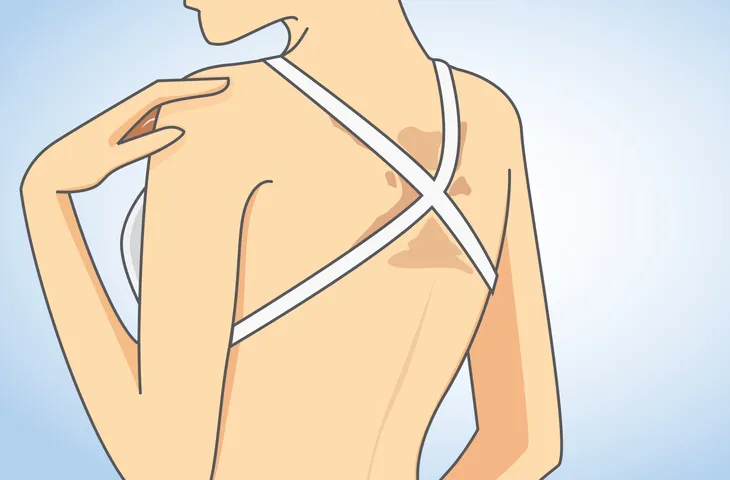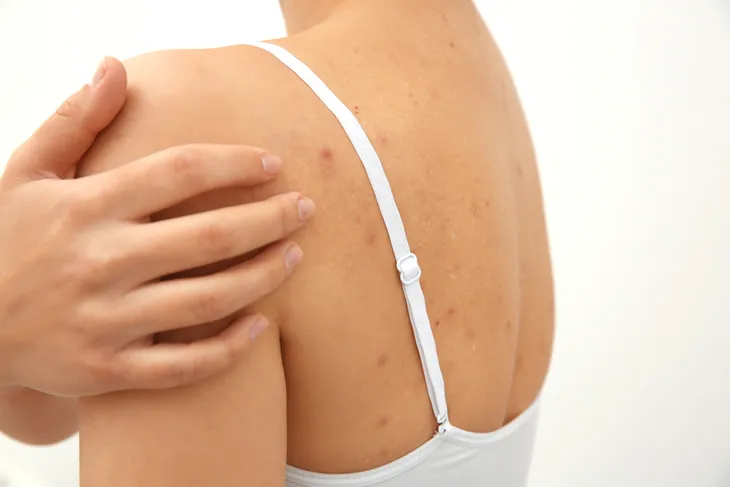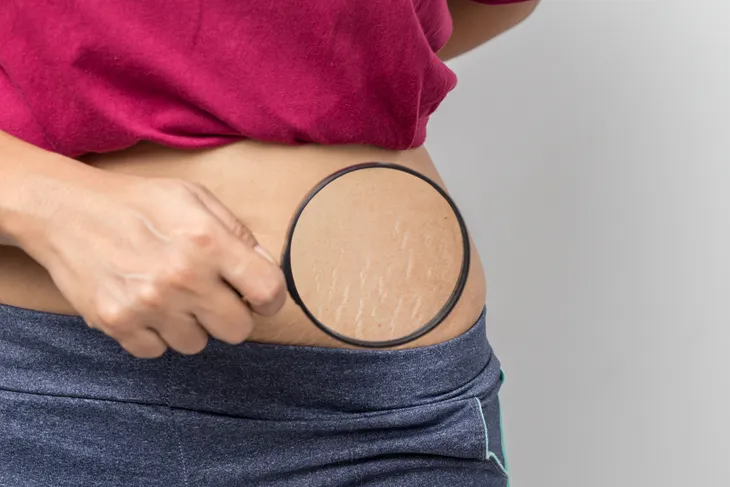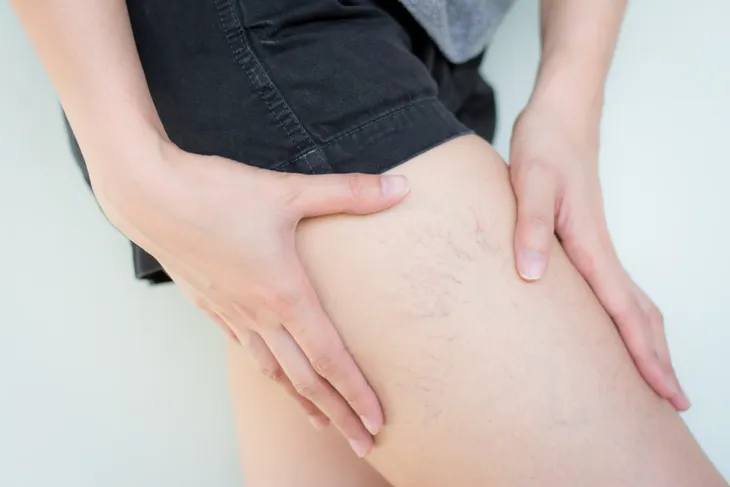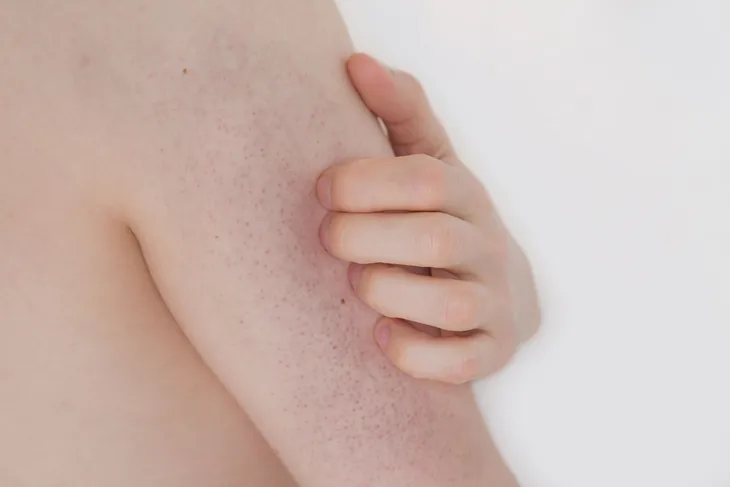If the idea of donning a summer swimsuit makes you recoil in fear, you may be dealing with less than glowing skin due to discoloration, spider veins, acne, a bumpy rash, or embarrassing scars.
Don’t be shy—take the advice of these professional dermatologists and get your skin ready for tank tops, mini-skirts, short-shorts, and bikinis with these 6 skin fixes…
Skin Discoloration
If the backs of your arms, or your neck, or chest look a little browner or redder than the rest of your visage, you may opt to cover up rather than embrace the tank top or scoop neck t-shirt. If you love to sunbathe, the thin skin on the sides of your neck could draw unflattering attention to an area stricken by years of sun damage, as well as alcohol consumption, and cigarette smoking. Just be sure to have any skin abnormalities checked out by a doctor to ensure you don’t have skin cancer.
Lightening creams are helpful but often not fully effective. You may need to consider procedures done in office. Dermatologist Dr. Eliot Battle recommends non-invasive laser skin resurfacing treatments administered by a dermatologist to banish discolored skin pigmentation, freckle spots, and redness that’s existed for more than a year. Light emitting device (LED) and factional laser treatments banish damaged skin cells caused by melanin overproduction and prevent further skin discoloration. You’ll also want to keep skin protected with a broad-spectrum sunscreen (SPF 30 or more) and cover exposed skin with dark clothing to avoid future sun damage.
Back Acne
If an outbreak of back acne, or “backne” has you covering your toned shoulders rather than baring them to the elements this summer—you’re not alone. According to Dr. Jeffrey Weinberg, Director of Clinical Research at St. Luke’s-Roosevelt Hospital Center, in New York, adult acne is a common yet under-dealt with issue.
The key to putting a stop to back acne is prevention. Consulting a dermatologist will prevent you from wasting a fortune on over-the-counter medicines that won’t solve your problem. A dermatologist can prescribe a single, effective treatment (i.e., antibiotic pills, Sotrel, Azelaic acid cream, Alpha-hydroxy acids, or Benzoyl peroxide topical treatments) that will prevent more acne and lead to acne scarring.
Stretch Marks
Stretch marks are a natural fact of life for all of us—especially if you’ve had a baby, a growth spurt, or lost or gained weight during your lifetime. And despite the marketing of many over-priced, over-the-counter creams, these hardly ever banish stretch marks, according to research published by the Journal of Dermatological Treatment. Instead, the research suggests seeking out a dermatologist for laser treatments before bathing suit season arrives.
Laser skin treatments aim to resurface the skin to banish discoloration, scarring, or stretch marks is always more effective before the skin absorbs that golden tanned glow. The study monitored the impact of fractional laser resurfacing on 19 females with stretch marks. Findings after one week showed a 51- to 75-percent improvement in the appearance of stretch marks.
Spider Veins
Those mortifying red and blue veins creeping up the sides and backs of your legs can be enough to have you covering your legs with long pants—despite the warm weather. Spider veins in contrast to varicose veins don’t typically swell or cause pain, but they’re still unattractive and embarrassing for many.
Luckily experts suggest a temporary and long-term fix. For short-term concealment, Dr. Jason Rivers, a Vancouver-Canada based dermatologist, and clinical professor at University of British Columbia, in Canada, suggests the use of a self-tanning product, which can be purchased over the counter at most drug stores to dull the appearance of spider veins under that nut-brown glow. A longer-term solution can be sought in sclerotherapy, a safe, dermatologist-administered procedure that involved injecting a sugar and salt solution directly into veins so they collapse and disappear. If the veins are superficial, laser treatment can be effective as well.
Keratosis Pilaris
You’re likely not familiar with keratosis pilaris unless you suffer from the condition, which causes a series of harmless, but rather embarrassing tiny bumps along the thighs, buttocks, arms, and face. Talk about a bummer during skin-bearing season!
According to research from the National Institutes of Health (NIH), keratosis pilaris is due to a skin protein, called keratin, which blocks hair follicles. NIH studies also claim that ruptured hair follicles can also cause these tiny red or white inflamed bumps to appear. The quick fix for banishing keratosis pilaris is exfoliation using a loofah or shower puff to slough away bumps. A deep moisturizing cream (look for creams containing retinol or hydroxy acids) will soften and tone affected areas.
Scarring
A surgery, injury or burn, chronic acne, or rough and tumble work or hobby can leave your body riddled with unsightly scars that you might not be so prone to show off during summer. Typically, scars dissipate with time, however, if yours demand a bit of extra encouragement, seeing a dermatologist before summer (before tanning) can help.
Depending on the type of scar, often tincture of time is all that’s needed. Sun protection is key to prevent further discoloration of scars. A topical retinoid can be effective and diminish the appearance over time. Your dermatologist can also perform chemical peels. Microneedling, and laser to help blend in the scars. Keloids scars that protrude may require steroid injections. Just be sure to consult with an expert so as not to worsen scarring.

